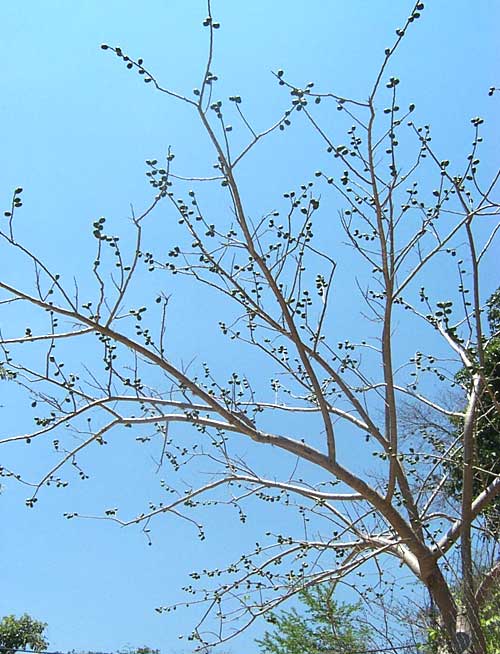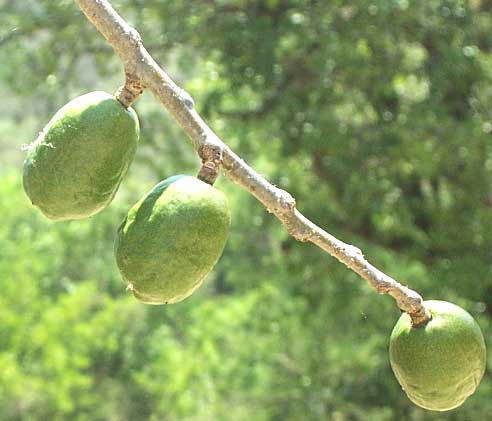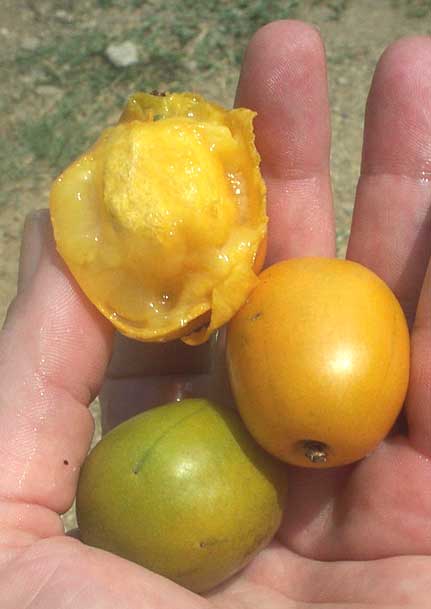Excerpts from Jim Conrad's
Naturalist Newsletter
from the May 12, 2007 Newsletter issued from Sierra Gorda Biosphere Reserve, QUERÉTARO, MÉXICO
SPANISH PLUMS IMPOSSIBLE TO IGNORE
If you ride down a road anyplace in this area two trees are more eye-catching than all others, both planted around people's homes: First, there's the awesomely crimson-blossomed Poinciana I told you about last week, and; second, there's a fruit tree with perfectly leafless branches very heavily loaded with oval, green, inch-long fruits. You can see a typical one of these below:

That's a close-up of three green fruits, which will turn yellow upon maturity, below:

Mexicans call the tree "Ciruelo," which translates to "plum," but the fruit is unlike what North Americans think of as a plum. In other parts of Latin America it goes by the name of Jocote. In English we call it Spanish Plum, Mombin, and other names. There's a species with both yellow- and red-fruited forms, Spondias purpurea, and there's another closely related species, Spondias mombin, which produces only yellow fruits. In Spondias purpurea flowers and fruits occur along the stem, while in Spondias mombin they're clustered at the end of the branch. Therefore, what we have above is the yellow-fruited form of Spondias purpurea. These are members of the Cashew Family, in which we also find mangos, sumacs and Poison Ivy. Spondias mombin is native from Mexico to northern South America but is planted worldwide in the tropics.
One reason the species is so popular is that its fruit can be eaten raw, used in preserves, made into jellies and, maybe most popular, used as the base for a sweet drink. I find its taste OK, but not to be compared with something like a fig or an apple. The trees ubiquity here may rest mainly on the fact that it doesn't need much care and thrives on marginal soils. One weakness is that it doesn't tolerate frosts.
Spanish Plum has been grown for so long that several horticultural varieties have emerged. The red-fruited form seems to receive top billing on the Internet, but the yellow-fruited one is much more common here. Also there are purple ones. Don Gonzalo says they taste pretty much the same.
You might enjoy reading the report of Allison Miller, a graduate student at Washington University in St. Louis, who traveled through Central America studying domesticated Spanish Plum populations. Allison found populations adapted for service in orchards, around people's homes, as living fences, cultivated in forests, as well as a few wild populations. Her interesting story, with pictures, is at http://www.mobot.org/MOBOT/Research/jocote/jocote.shtml.
from the June 22, 2007 Newsletter issued from Sierra Gorda Biosphere Reserve, QUERÉTARO, MÉXICO
SPANISH PLUMS ARE RIPE
Jalpan's Spanish Plums are finally maturing and I'm eating my share. Last weekend as I hiked through a village in the valley below San Juan, Zoyapilca, I met two old women and a young man coming down the road, each carrying two buckets filled to their brims with Spanish Plums. On my walk to the market there's one place where the sidewalk is dangerously slick with squashed, fallen plums. Three plums are shown in my hand below:

Though Spanish Plums belong to an entirely different plant family from northern plums, you can see why they're called plums. They look and taste like northern plums, and similarly can be eaten raw and made into preserves. However, note the large, hard, white, blocky seed, which is very unlike the northern plum's lens- shaped pit. Spanish Plums belong to the mostly tropical Cashew Family, in which we find not only cashew and mango trees but also sumac, Poison Oak and Poison Ivy.
Here people call the fruit Ciruela, which means plum, and they always tell you that there are two kinds, a yellow one and a red one. So, this is the yellow-fruited form of SPONDIAS PURPUREA.
Nowadays the trees' pinnately compound, walnut-tree- like leaves have emerged and the plentiful yellow fruits set amidst fresh, emerald green leaves are very pretty. An infusion of the leaves, by the way, is effective in treating viral herpes infections, as reported at http://www.cravoecanela.com/Herpes_2.html.